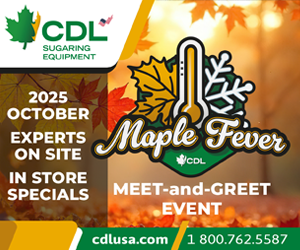Candy & Cream
Unlocking the potential of sugar
Dark syrups with high inverts may make better product
By AILIS CLYNE, AARON WIGHTMAN, STEVE CHILDS | APRIL 8, 2020
VAN ETTEN, N.Y.—Maple sugar has unrealized potential as a product with unlimited applications.
Despite variability in the product there is not much variation in what is offered for sale.
Most producers use the same guidelines and methods for producing sugar – typically using low-invert syrups which result in light colored and weakly flavored sugar. We’ve been experimenting with strengthening this flavor using darker syrups.
The advantage of using low invert sugars and the traditional method is a sugar product with consistent crystal sizes, and acceptable flavor and moisture content.
The drawback is relatively weak maple flavor that is easily overwhelmed by other ingredients. Many popular confections are made with strong flavor ingredients that mask the flavor of the sweetener.
These include chocolates, licorice, jelly candies, and mint candies. When these products are made with maple sugar, the maple flavor does not come through as well as desired.
This issue has limited maple sugar from accessing some confection industries.
With new, alternative processing methods, however, a stronger flavored maple sugar can be achieved. Utilizing dark, high-invert syrup can create a sugar that stands out in the flavor profile of these types of confections.
Furthermore, maple sugar varies in crystal sizes, depending on several factors, but especially on the method chosen for stirring the hot syrup as it cools.
Making sugar with dark syrup exacerbates this issue, yielding a wide range of crystal sizes and clumps of crystals that are difficult to break down into small granules with a screen.
We have been experimenting with a sieve shaker machine to separate the crystal sizes for diverse applications.
For example, to make cotton candy, you would avoid sugar that is too fine, but for something like a beverage, or smooth textured confection made with fats, the finer the crystal size, the better!
The sieve shaker has revealed to us how various stirring methods affect the final product, resulting in different proportions of sugar crystal sizes in the final product.
Using a Hobart mixer results in a much higher proportion of very fine crystals than stirring by hand or using a turntable cream machine.
These results were shared during a sieve shaker demo at this year’s Annual Maple Conference in Syracuse.
Crystal isn’t the only form that dry sugar can take. We have been experimenting with using high invert syrups to create a glass.
Pulverize this glass, and you have a new type of sugar with strong flavor and unique properties.
In a recent experiment, we produced glass by cooking a very dark syrup with an invert of 5.7% to 300 F.
The glass was processed using a grain grinder resulting in fine sugar particles with intense flavor. This research is still in its infancy. We can’t answer many questions about this technique just yet as we still have many questions ourselves.
Maple sugar has the potential to fill numerous applications that have yet been unexplored.
We are working to bring new maple-based products from proof of concept straight to market.
The future of maple sugar is prolific use in all your favorite products, available at a grocery store near you.


































